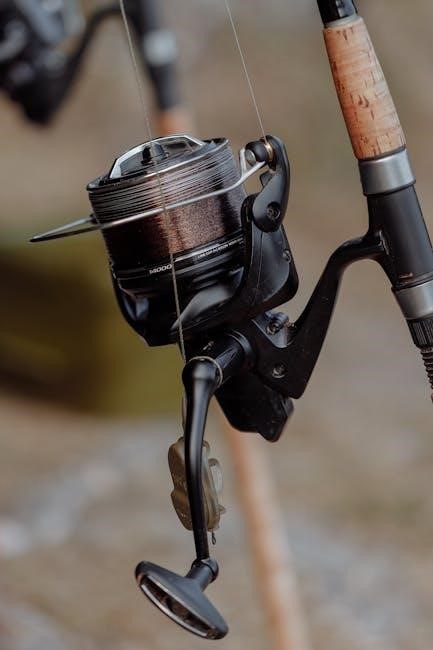Rod guides are essential components of a fishing rod, enhancing line control and casting precision. They improve casting distance and reduce line tangles, crucial for anglers of all levels.
What Are Rod Guides?
Rod guides are circular or oval-shaped components attached along the length of a fishing rod. They serve as pathways for the fishing line, ensuring smooth line flow and consistent tension. By spacing the guides evenly, they help distribute stress across the rod, reducing the risk of line tangles and improving casting accuracy. These guides often feature materials like ceramic, stainless steel, or titanium, each offering unique benefits for different fishing conditions. Properly aligned rod guides enhance the overall performance of the rod, making them a critical element for anglers seeking precision and control during casting and reeling. Their design plays a vital role in balancing the rod’s sensitivity and durability, making them indispensable for both novice and experienced fishermen alike.
Importance of Rod Guides in Fishing
Rod guides play a crucial role in enhancing fishing performance by allowing for smoother line flow and improved casting distance. They minimize line tangles and abrasion, ensuring a more enjoyable and efficient fishing experience. By reducing friction, rod guides enable better sensitivity, making it easier to detect even the slightest bites. Additionally, they provide consistent tension, which is vital for setting hooks effectively. Durable and well-designed guides also withstand harsh fishing conditions, protecting both the rod and the line. Their strategic placement along the rod ensures balanced casting and reeling, making them indispensable for anglers seeking precision and control. Ultimately, rod guides are a fundamental component that elevates the overall effectiveness of a fishing rod, making them essential for both casual and professional anglers.

Types of Rod Guides
Rod guides are available in ceramic, stainless steel, and titanium, each offering unique benefits like smooth line flow, durability, and resistance to corrosion and heat in various fishing environments for optimal performance.
Ceramic Rod Guides
Ceramic rod guides are renowned for their exceptional heat resistance and smooth line flow, minimizing friction to reduce wear on fishing lines and enhance casting performance. They are ideal for use with monofilament, fluorocarbon, and braided lines, offering durability and resistance to corrosion, making them suitable for both fresh and saltwater fishing. The ceramic material ensures a consistent and reliable performance, even in harsh conditions, making these guides a popular choice among anglers seeking precision and longevity. Their ability to maintain line integrity and reduce the risk of line damage is a key factor in their widespread adoption across various fishing environments. Additionally, ceramic guides are known for their lightweight construction, contributing to an overall balanced rod feel, which is crucial for anglers who require both sensitivity and strength during their fishing excursions. This combination of attributes makes ceramic rod guides a versatile and dependable option for anglers of all skill levels, ensuring improved casting accuracy and line management.

Stainless Steel Rod Guides
Stainless steel rod guides are highly durable and resistant to corrosion, making them ideal for saltwater and harsh fishing environments. They are known for their exceptional strength and ability to withstand heavy use, ensuring long-lasting performance. These guides are often preferred by anglers who prioritize reliability and resilience, as they can handle large fish and rough conditions without compromising line flow. While they may be slightly heavier than other materials, stainless steel guides offer unmatched durability and are a cost-effective option for those seeking a balance between performance and affordability. Their robust construction ensures minimal wear and tear, making them a practical choice for anglers who demand reliability in their fishing gear.
Titanium Rod Guides
Titanium rod guides are renowned for their exceptional strength-to-weight ratio and corrosion resistance, making them ideal for both freshwater and saltwater fishing. Their lightweight design reduces rod weight, enhancing sensitivity and maneuverability, while their durability ensures consistent performance in harsh conditions. Titanium guides are highly resistant to saltwater corrosion, making them a preferred choice for anglers fishing in coastal or brackish environments. The smooth surface of titanium guides minimizes line friction, allowing for smoother casting and longer casting distances. Additionally, their flexibility helps prevent line breakage during intense battles with large fish. Titanium rod guides are a premium option for anglers seeking a balance of strength, durability, and lightweight performance, making them a worthwhile investment for serious fishing enthusiasts.

How to Choose the Right Rod Guides
Selecting the right rod guides involves considering factors like fishing conditions, rod type, and line size. Proper guide size and material ensure optimal performance and durability. Research and testing help anglers make informed decisions, ensuring their gear meets specific fishing needs for enhanced results on the water.
Guide Size and Type

Guide size and type play a critical role in determining the performance of a fishing rod. Larger guides are ideal for thicker lines and heavier fishing applications, as they reduce friction and prevent line wear. Smaller guides, on the other hand, are better suited for lighter lines and more precise casting. The type of guide, whether it’s a standard ring, micro guide, or a specialized guide, also impacts casting distance and accuracy. Anglers should consider the specific fishing conditions and the type of fishing they will be doing when selecting guide size and type. Proper selection ensures optimal line flow and reduces the risk of tangles. Additionally, the spacing between guides is important for maintaining consistent line tension and preventing line twist. By choosing the right guide size and type, anglers can enhance their overall fishing experience and improve their chances of a successful catch. Proper guide alignment and configuration also contribute to better rod sensitivity, allowing anglers to feel even the slightest bites. In summary, guide size and type are essential factors that directly influence the rod’s performance and the angler’s effectiveness on the water.
Material Selection for Different Fishing Conditions
Choosing the right material for rod guides depends on the fishing environment and conditions. Ceramic guides are ideal for saltwater fishing due to their corrosion resistance and smooth line flow. Stainless steel guides are durable and suitable for heavy-duty fishing, offering excellent strength and resistance to wear. Titanium guides, while more expensive, provide exceptional corrosion resistance and are lightweight, making them perfect for freshwater and trolling applications. For icy or extreme cold conditions, titanium or ceramic guides are preferred as they maintain performance in freezing temperatures. Anglers should also consider line type and fishing technique when selecting guide materials, as different materials interact differently with various line types. Proper material selection ensures longevity, improves casting performance, and enhances the overall fishing experience.

Installation and Maintenance
Proper installation and maintenance of rod guides ensure optimal performance. Use threadlocker and align guides carefully. Regular cleaning prevents debris buildup. Replace worn guides promptly for best results.
How to Install Rod Guides
Installing rod guides requires precision and care. Start by selecting the appropriate guide size for your rod. Clean the rod surface thoroughly before applying threadlocker to prevent slippage. Align the guide with the rod’s spine, ensuring proper positioning for smooth line flow. Wrap the thread around the guide foot, leaving slight spacing for even adhesion. Tighten gradually, avoiding overtightening, which can damage the rod. Once secured, inspect the alignment and test flexibility. Proper installation ensures durability and enhances casting performance, making it crucial for anglers to follow these steps meticulously to achieve optimal results and extend the rod’s lifespan.
Cleaning and Protecting Rod Guides
Cleaning and protecting rod guides is crucial for maintaining their performance and longevity. Regularly inspect and remove dirt, grime, and old line residue using a soft cloth and mild soap. Avoid harsh chemicals or abrasive materials that could damage the guides. After cleaning, dry thoroughly to prevent rust or corrosion. Apply a light layer of silicone spray or specialized rod guide lubricant to protect against wear and environmental factors. For saltwater fishing, rinse guides with fresh water after use to remove salt residue. Proper maintenance ensures smooth line flow, reduces friction, and prevents guide damage, ultimately enhancing your fishing experience and extending the life of your equipment.
Advanced Techniques
Advanced techniques with rod guides involve optimizing line flow and casting distance through precise guide alignment and material selection, enhancing fishing efficiency and accuracy for expert anglers.

Using Rod Guides for Specific Fishing Styles

Rod guides are tailored to specific fishing styles, ensuring optimal performance. For fly fishing, larger guides accommodate thicker lines, while spinning rods benefit from smaller, lighter guides. Saltwater fishing often requires corrosion-resistant guides like stainless steel or titanium to withstand harsh environments. In baitcasting, strategically placed guides improve line control and casting accuracy. The guide size and material should match the fishing technique and conditions, such as freshwater, saltwater, or ice fishing. Properly selected rod guides enhance sensitivity, reduce line friction, and increase casting distance, making them indispensable for anglers targeting specific species or using particular methods. This versatility ensures improved fishing efficiency and a more enjoyable experience.
Optimizing Line Flow and Casting Distance
Optimizing line flow and casting distance begins with selecting the right rod guides. Properly sized guides reduce line friction, allowing for smoother casts and greater accuracy. Larger guides near the reel improve line flow, while smaller guides toward the tip enhance sensitivity. Maintaining clean guides ensures minimal resistance, maximizing casting efficiency. Aligning guides straight and evenly prevents line tangling and improves casting performance. Using high-quality materials like ceramic or titanium further reduces friction and wear. Regular cleaning and inspection of guides prevent debris buildup, ensuring optimal line flow. By pairing the right guide size with appropriate material, anglers can achieve longer, more precise casts, making rod guides a critical factor in successful fishing outings. Proper guide setup is essential for maximizing casting potential and overall fishing success.
Rod guides are crucial for enhancing fishing experiences by improving line control and casting precision. Proper maintenance ensures durability and optimal performance for anglers of all skill levels and preferences.
Final Thoughts on Rod Guides
Rod guides are indispensable for anglers, enhancing line control, casting precision, and overall fishing performance. Available in materials like ceramic, stainless steel, and titanium, they cater to diverse fishing conditions. Proper guide size selection ensures optimal line flow and minimizes friction, while regular maintenance prolongs their lifespan. Whether for freshwater or saltwater fishing, high-quality rod guides improve casting distance and reduce tangles, making them a vital component for both novice and experienced anglers. By understanding their importance and maintaining them well, anglers can elevate their fishing experiences and achieve better results on the water.
Future Trends in Rod Guide Technology
Future trends in rod guide technology focus on innovative materials and smart designs. Advanced nano-ceramic coatings promise reduced friction and enhanced durability, while lightweight titanium alloys improve strength-to-weight ratios. Smart rod guides with integrated sensors could provide real-time feedback on line tension and fish behavior. Customizable guides tailored to specific fishing styles and conditions may become mainstream, offering anglers personalized performance. Additionally, advancements in 3D printing could enable rapid prototyping and production of complex guide designs. These innovations aim to enhance casting accuracy, reduce wear, and improve overall fishing efficiency, making rod guides even more indispensable for anglers worldwide.